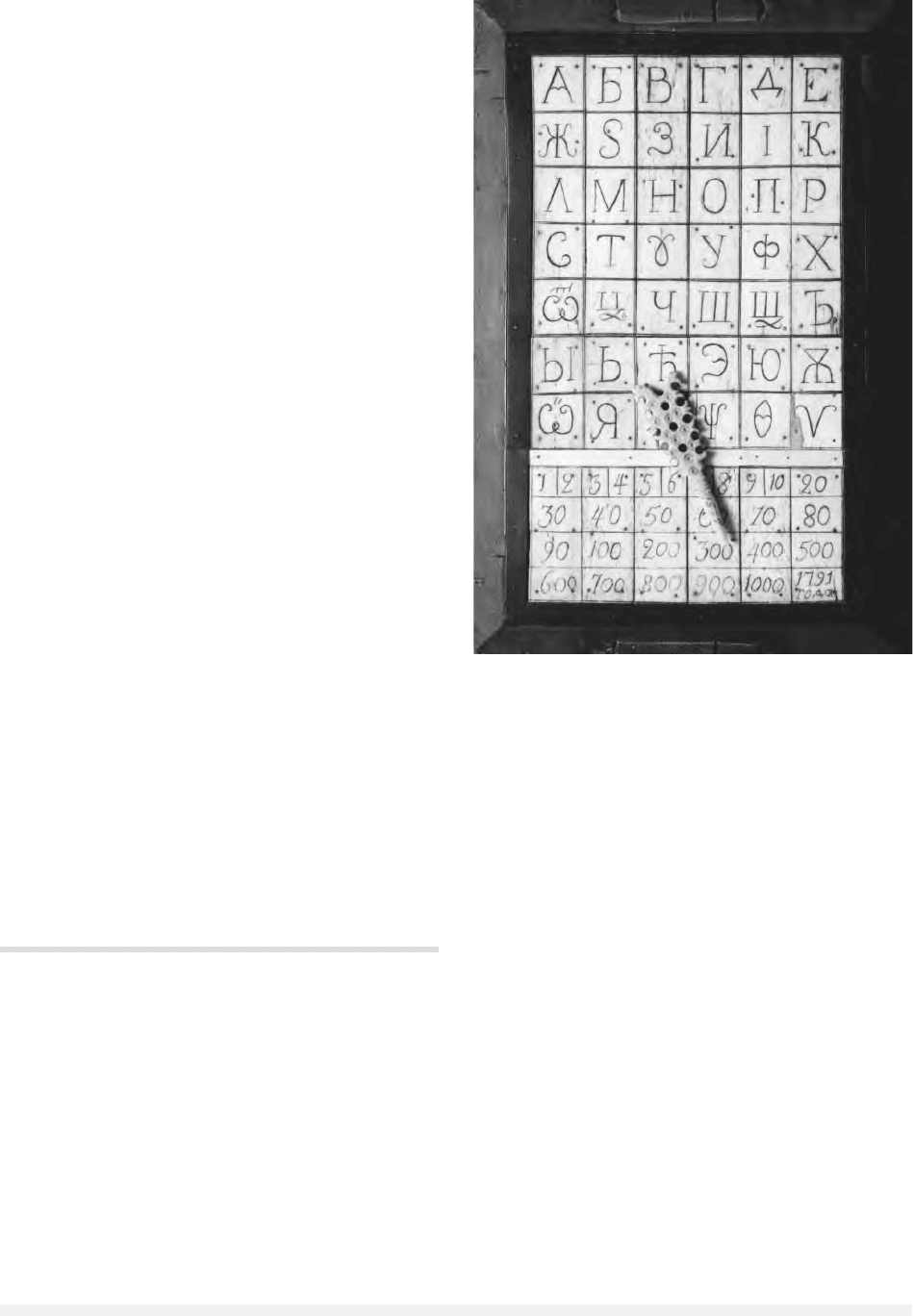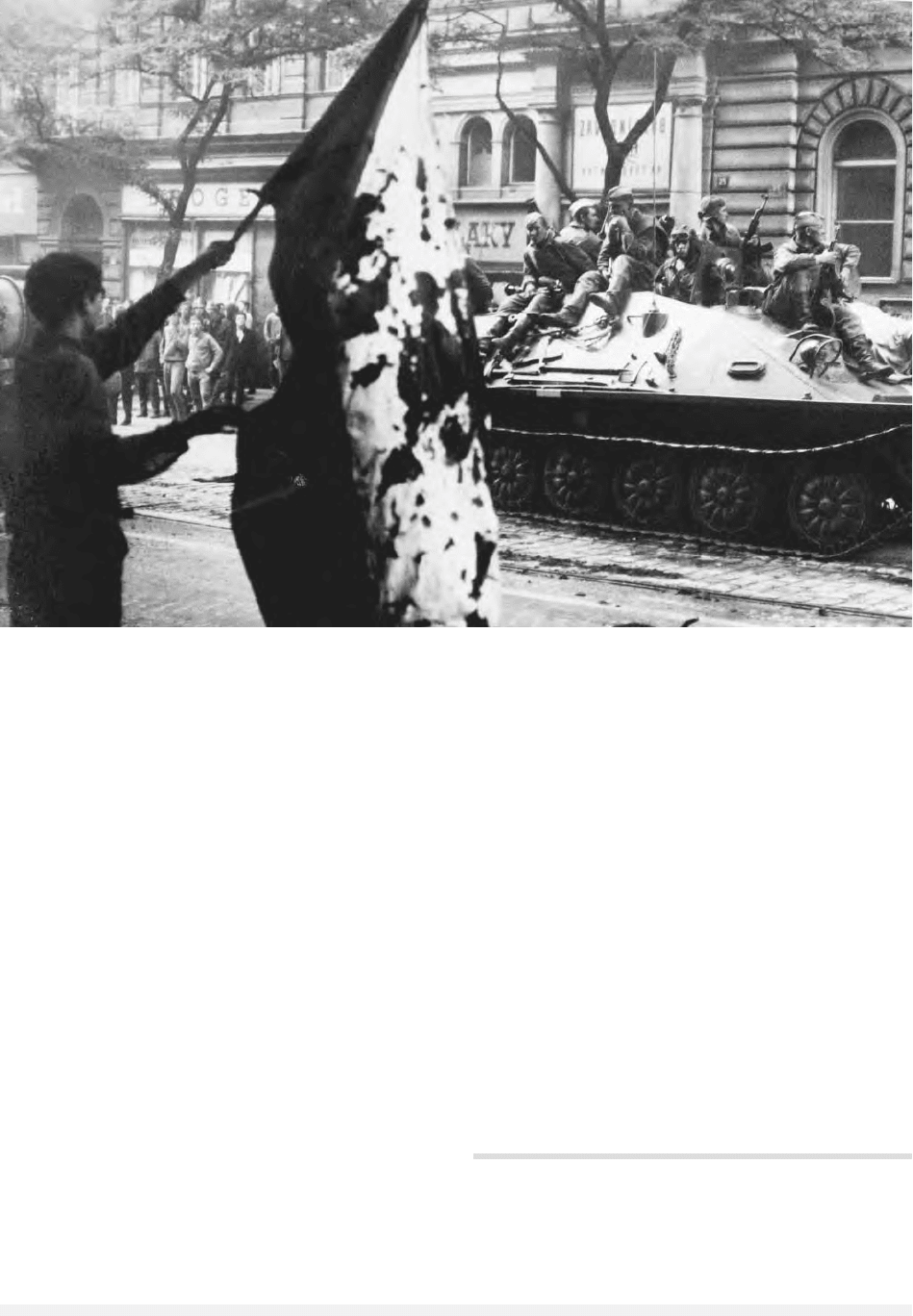Encyclopedia of Russian History
Подождите немного. Документ загружается.


the Russian establishment for its quasi-military
structure introduced by Peter I. Most astounding
among his conclusions was the prediction that Rus-
sia would face a revolution of unprecedented scope
within the next half century.
When Russia in 1839 was published in four
lengthy volumes in 1843, it became an immediate
bestseller and was translated into English, German,
and Danish. Russian diplomats and secret agents
tried their utmost to discredit the book and its au-
thor; the tsar himself reportedly had a fit of fury
while reading Custine’s elaborations. On the other
hand, Alexander Herzen and other dissidents
praised Russia in 1839 for its accuracy, and even
the chief of Russia’s Third Department conceded
that the ungrateful French guest merely said out
loud what many Russians secretly were thinking
in the first place.
Astolphe de Custine, who also wrote other
travelogues and fiction, died in 1857.
See also: AUTOCRACY; NICHOLAS I.
BIBLIOGRAPHY
Custine, Marquis de. (1989). Empire of the Czar: A Jour-
ney through Eternal Russia. New York: Doubleday.
Grudzinska Gross, Irena. (1991). The Scar of Revolution:
Custine, Tocqueville, and the Romantic Imagination.
Berkeley: University of California Press.
P
ETER
R
OLLBERG
CUSTOMS BOOKS
Customs books (tamozhennye knigi) were official
registers of customs and other revenues collected at
customs offices between the sixteenth and the mid-
eighteenth centuries, and often a source of data on
expenditures by the customs administration.
Typical entries in a customs book list the quan-
tities and values of the commodities carried by a
given merchant. In addition, they usually give the
name, rank, origin, and destination of each mer-
chant. Customs records often include separate sec-
tions on particular “special” commodities, such as
liquor, horses, cattle, grain, or treasury goods.
All Russian towns, as well as many smaller
communities, kept records of all trade passing
through them. A total of some 190 seventeenth-
century customs books have survived to this day.
Although the collection has been repeatedly deci-
mated over time, varying numbers of customs
books still exist for fifty cities in European Russia
and for most of the Siberian fortress towns, virtu-
ally all of them dated between 1626 and 1686. The
best-preserved collections of early modern customs
data are for the Southern Frontier, the Northern
Dvina waterway, and the Siberian fortress towns.
In contrast, practically all the information of the
key commercial centers of Moscow, Yaroslavl’,
Arkhangel’sk, and Novgorod, among others, has
been lost.
For the early eighteenth century, customs data
pertaining to some 300 towns have survived. Dated
from 1714 to 1750, 142 books survive in the col-
lections of the Kamer-kollegia. The most important
collections are for Moscow, Northern Russia, and
the Southern Frontier. The practice of compiling
customs books was discontinued following the
abolition of internal customs points in 1754.
See also: FOREIGN TRADE; MERCHANTS
BIBLIOGRAPHY
Hellie, Richard. (1999). The Economy and Material Culture
of Russia, 1600–1725. Chicago: University of
Chicago Press.
J
ARMO
T. K
OTILAINE
CYRIL AND METHODIUS SOCIETY
The first Ukrainian political organization in the
Russian Empire, the Cyril and Methodius Brother-
hood existed from late 1845 to early 1847. A se-
cret society with no clear membership criteria, the
brotherhood consisted of a core group of some
dozen members and a wider circle of an estimated
one hundred sympathizers. The society was led by
the historian Mykola (Nikolai) Kostomarov, the mi-
nor official Mykola Hulak, and the schoolteacher
Vasyl Bilozersky. Scholars continue to disagree as
to whether the great poet Taras Shevchenko, the
most celebrated affiliate of the group, was a formal
member. This organization of young Ukrainian pa-
triots was established in Kiev in December 1845
and, during the fourteen months of its existence,
its activity was limited to political discussions and
the formulation of a program. Kostomarov wrote
the society’s most important programmatic state-
ment, “The Books of the Genesis of the Ukrainian
CYRIL AND METHODIUS SOCIETY
353
ENCYCLOPEDIA OF RUSSIAN HISTORY

People.” Strongly influenced by Polish Romanticism
and Pan-Slavism, this document spoke vaguely of
the Christian principles of justice and freedom, but
also proposed a number of radical reforms: the abo-
lition of serfdom, the introduction of universal ed-
ucation, and the creation of a democratic federation
of all the Slavic peoples with the capital in Kiev.
The members of the brotherhood disagreed about
priorities and ways of implementing their program.
Kostomarov, who stressed the Pan-Slavic ideal, ex-
pressed the majority opinion that change could be
achieved through education and moral example.
Hulak and Shevchenko advocated a violent revolu-
tion. Shevchenko, together with the writer Pan-
teleimon Kulish, saw the social and national
liberation of Ukrainians as the society’s priority. In
March 1847 a student informer denounced the so-
ciety to the authorities, leading to the arrest of all
active members. Most of them were subsequently
exiled to the Russian provinces, but Hulak received
a three-year prison term, while Shevchenko’s po-
ems earned him ten years of forced army service
in Central Asia. Soviet historians emphasized the
difference between radicals and liberals within the
brotherhood, while in post-Soviet Ukraine the
group is seen as marking the Ukrainian national
movement’s evolution from the cultural stage to a
political one.
See also: NATIONALITIES POLICIES, TSARIST; UKRAINE AND
UKRAINIANS
BIBLIOGRAPHY
Luckyj, George S. N. (1991). Young Ukraine: The Brother-
hood of Saints Cyril and Methodius in Kiev, 1845–1847.
Ottawa: University of Ottawa Press.
S
ERHY
Y
EKELCHYK
CYRILLIC ALPHABET
Russian and other Slavic languages are written us-
ing the Cyrillic alphabet. The letter system has been
attributed to Cyril and Methodius, two brothers
from Greek Macedonia working as Orthodox mis-
sionaries in the ninth century. Cyril invented the
Glagolitic (from the word glagoliti, “to speak”)
script to represent the sounds they heard spoken
among the Slavic peoples. By adapting church rit-
uals to the local tongue, the Orthodox Church be-
came nationalized and more accessible to the
masses. Visually, Glagolitic appears symbolic or
runic. Later St. Clement of Ohrid, a Bulgarian arch-
bishop who studied under Cyril and Methodius,
created a new system based on letters of the Greek
alphabet and named his system “Cyrillic,” in honor
of the early missionary.
Russian leaders have standardized and stream-
lined the alphabet on several occasions. In 1710,
Peter the Great created a “civil script,” a new type-
face that eliminated “redundant” letters. Part of Pe-
ter’s campaign to expand printing and literacy, the
civil script was designated for all non-church pub-
lications. The Bolsheviks made their own ortho-
graphic revisions, dropping four letters completely
to simplify spelling. As non-Russian lands were in-
corporated into the Soviet Union, the Communist
Party decreed that all non-Russian languages had
to be rendered using the Cyrillic alphabet. Follow-
ing the collapse of the USSR, most successor states
seized the opportunity to restore their traditional
Latin or Arabic script as a celebration of their na-
tional heritage.
CYRILLIC ALPHABET
354
ENCYCLOPEDIA OF RUSSIAN HISTORY
An eighteenth-century carved bone and wood panel with the
Cyrillic alphabet. © M
ASSIMO
L
ISTRI
/CORBIS

Transliteration is the process of converting let-
ters from one alphabet to another alphabet system.
There are several widely used systems for translit-
erating Russian into English, including the Library
of Congress system, the U.S. Board of Geographic
Names system, and the informally named “lin-
guistic system.” Each system offers its own ad-
vantages and disadvantages in terms of ease of
pronunciation and linguistic accuracy.
This Encyclopedia uses the U.S. Board of Geo-
graphic Names system, which is more accessible for
non-Russian speakers. For example, it renders the
name of the first post-communist president as
“Boris Yeltsin,” not “Boris El’tsin.” The composer of
the Nutcracker Suite and the 1812 Overture becomes
“Peter Tchaikovsky,” not “Piotr Chaikovskii.”
See also: BYZANTIUM, INFLUENCE OF; NATIONALITIES
POLICIES, SOVIET; PETER I
BIBLIOGRAPY
Gerhart, Genevra. (1974). The Russian’s World: Life and
Language. New York: Harcourt Brace Jovanovich.
Hughes, Lindsey. (1988). Russia in the Age of Peter the
Great. New Haven, CT: Yale University Press.
A
NN
E. R
OBERTSON
CYRIL OF TUROV
(c. 1130–1182), twelfth-century church writer,
bishop.
The facts of Cyril’s (Kirill’s) life and career are
disputable, since contemporary sources for both are
lacking. Customarily, it is asserted that he was
born to a wealthy family in Turov, northwest of
Kiev, about 1130 and died not later than 1182;
that he was a monk who rose to be bishop of Turov
in the late 1160s; and that he wrote letters to
Prince Andrei Bogolyubsky about a rival bishop.
Cyril’s brief Prolog (Synaxarion) life (translation
in Simon Franklin’s Sermons and Rhetoric of Kievan
Rus’), written probably long after his death, is the
only “authority” for most of these claims, al-
though it is vague and gives no dates. Whether all
of the works attributed to him were his, and
whether he was ever in fact a bishop (the texts
usually call him simply the “unworthy” or “sin-
ful monk Cyril”) are matters of speculation and
scholarly convention.
Tradition credits more extant writings to Cyril
of Turov than to any other named person thought
to have lived in the Kievan period. They include ser-
mons, parables, and edifying stories. The corpus of
texts attributed to Cyril was critically studied and
edited in the 1950s by the late philologist Igor
Petrovich Yeremin. Simon Franklin considers the
“stable core” of the oeuvre to consist of three sto-
ries and eight sermons, while various other writ-
ings have frequently been added.
The eight sermons, which no doubt are Cyril’s
most admired works today, form a cycle for the
Easter season stretching from Palm Sunday to the
Sunday before Pentecost. Like the famous Sermon
on Law and Grace of Hilarion, they are heavily de-
pendent on Byzantine Greek sources and, of course,
incorporate many Biblical quotations and para-
phrases. The original accomplishment of Cyril was
to express all this in a fluent and vigorous Church
Slavonic language that makes it fresh and living.
Cyril’s style is elaborate and rich in poetic tropes,
particularly metaphors. A familiar example is his
extended comparison of the resurrection with the
coming of spring in the world of nature, where (in
the manner of Hilarion) he quickly resolves the
metaphors and reveals explicitly the higher mean-
ing for salvation history.
Another typical feature of Cyril’s sermons is
the extensive use of dramatic dialogue, very wel-
come in a church literature otherwise devoid of
liturgical drama. Thus the speech of Joseph of Ari-
mathaea (with his repeated plea, “Give me body of
Christ”) and others in the Sermon for Low Sunday
both instruct and convey deep emotion.
See also: HILARION; RUSSIAN ORTHODOX CHURCH
BIBLIOGRAPHY
Franklin, Simon, tr. and intro. (1991). Sermons and
Rhetoric of Kievan Rus’. Harvard Library of Early
Ukrainian Literature, Vol. 5. Cambridge, MA: Dis-
tributed by the Harvard University Press for the
Ukrainian Research Institute of Harvard University.
N
ORMAN
W. I
NGHAM
CZARTORYSKI, ADAM JERZY
(1770–1861), Polish statesman, diplomat, and sol-
dier.
Prince Adam Jerzy Czartoryski was the scion of
an aristocratic Polish family, the son of Prince Adam
Kazimierz and Izabella (nee Fleming) Czartoryski.
CZARTORYSKI, ADAM JERZY
355
ENCYCLOPEDIA OF RUSSIAN HISTORY

He fought in the Polish army during the war of the
second partition in 1793, after which his father’s
estates were confiscated by the Russians. In a last-
ditch attempt to salvage his property, Czartoryski’s
father sent Adam and his brother Constantine to the
Court of St. Petersburg. Summoning all his courage,
Czartoryski befriended the grandson of Empress
Catherine II, the Grand Duke Alexander, in the
spring of 1796. Hoping that Alexander would soon
be tsar, Czartoryski filled his friend’s head with ideas
about Polish freedom. When Alexander became em-
peror in 1801, after the murder of his father Paul,
he appointed Czartoryski as Russian Minister of For-
eign Affairs.
Now one of Tsar Alexander’s trusted advisors,
Czartoryski intervened on behalf of the Poles when-
ever he could, repeatedly advocating the restoration
of Poland to its 1772 boundaries, a Russian-
English alliance, and the diplomatic recognition of
Napoleonic France as a method of deterrence.
Deeming Austria and Prussia to be Russia’s main
enemies, Czartoryski resigned in protest when the
tsar formed an alliance with Prussia. He neverthe-
less continued to champion Polish independence af-
ter Napoleon’s unsuccessful war with Russia,
attending the Congress of Vienna (1814) and plead-
ing with British and French statesmen. On May 3,
1815, the Congress of Vienna did establish the so-
called Congress Kingdom of Poland, a small state
united with Russia but possessing its own army
and local self-government. Cruelly, however,
Alexander appointed Adam’s brother Constantine
as commander-in-chief of the Polish army and
shunted Adam aside, never to be called again to
government service.
Czartoryski participated in the Polish insurrec-
tion of 1830 and 1831, and briefly headed a pro-
visional Polish government. However, the Russians
crushed the rebellion, and Czartoryski was sen-
tenced to death. Fleeing to Paris, he set up a polit-
ical forum for Polish émigrés from the Hôtel
Lambert, where he resided. Only among the Hun-
garians, in armed revolt against the Habsburg em-
pire in 1848, did the Hôtel Lambert group find, and
give, support. Many Poles joined the Hungarian
army as officers and soldiers. Nevertheless, the Ho-
tel’s influence also faded, along with Czartoryski’s
dream of Polish independence in his lifetime.
See also: ALEXANDER I; POLAND
BIBLIOGRAPHY
Czartoryski, Adam Jerzy, and Alexander; Gielgud Adam.
(1968). Memoirs, Prince Adam Czartoryski and His
Correspondence with Alexander I, with Documents Rel-
ative to the Prince’s Negotiations with Pitt, Fox, and
Brougham, and an Account of his Conversations with
Lord Palmerston and Other English Statesmen in Lon-
don in 1832. Orono, ME: Academic International.
J
OHANNA
G
RANVILLE
CZECHOSLOVAK CORPS See CIVIL WAR OF
1917–1922.
CZECHOSLOVAKIA, INVASION OF
Late in the evening of August 20, 1968, Czecho-
slovakia was invaded by five of its Warsaw-Pact
allies: the Soviet Union, East Germany, Poland,
Hungary, and Bulgaria. The invasion force, which
eventually totaled around half a million soldiers,
6,300 tanks, and 800 airplanes, targeted its entry
from the north, northwest, and south to quickly
neutralize the outnumbered Czechoslovak army.
The immediate objective of the invasion was to
prevent any resistance to the seizure of power by
collaborators in the Czechoslovak Communist
Party (KSC
), who had signaled their agreement
with Soviet disapproval of First Secretary Alexan-
der Dubc
ek’s reform program and leadership style.
Although it caused the deaths of around 100 civil-
ians and is often credited with putting an end to
the “Prague Spring,” the invasion failed in many
political and logistical respects, and its larger aims
were met only months later by other means.
The possibility of military intervention in
Czechoslovakia had been entertained in the Brezh-
nev Politburo from at least as early as March 1968,
only weeks after Dubc
ek had risen (with Soviet
blessing) to the top of the KSC
. At first, the ma-
jority of Soviet leaders preferred to pressure Dubc
ek
into reimposing censorship over the mass media,
silencing critical intellectuals, and removing the
bolder reformers within the party. His repeated
promises to restore control temporarily prevailed
over the demands of Polish, East German, and Bul-
garian leaders for Soviet-led military action. The
Politburo was also restrained by its lack of personal
contacts with, and trust in, other Czech and Slo-
vak functionaries, to whom power would have to
be entrusted.
By mid-July 1968, Soviet patience with Dubc
ek
had been exhausted, and alternative leaders had
CZECHOSLOVAKIA, INVASION OF
356
ENCYCLOPEDIA OF RUSSIAN HISTORY

been identified. Under the cover of war games in
and around Czechoslovakia, twenty divisions
moved into striking position. After the failure of
several last attempts to persuade Dubc
ek to take
the initiative in reversing his reforms, the Politburo
concluded on August 17 that military intervention
was unavoidable. The Czech and Slovak collabora-
tors, however, botched their bid to seize power, and
the invading armies’ overextended supply lines
broke down, forcing soldiers to beg for food and
water from a hostile populace engaging in highly
effective, nonviolent resistance. In Moscow, the So-
viet powers decided to bring Dubc
ek and his clos-
est colleagues to the Kremlin. After three days of
talks, a secret protocol was signed that committed
the KSC
leadership to the restoration of censorship
and a purge of the party apparatus and govern-
ment ministries. Dubc
ek remained at the helm of
the KSC
until April 1969, when Moscow-fueled in-
trigue led to his replacement by the more amenable
Gustáv Husák.
See also: BREZHNEV DOCTRINE; CZECHOSLOVAKIA, RELA-
TIONS WITH
BIBLIOGRAPHY
Dawisha, Karen. (1984). The Kremlin and the Prague
Spring. Berkeley, CA: University of California Press.
Kramer, Mark. (1992–1993). “New Sources on the 1968
Soviet Invasion of Czechoslovakia.” Cold War Inter-
national History Project Bulletin, 2–3.
Williams, Kieran. (1997). The Prague Spring and its After-
math: Czechoslovak Politics, 1968–1970. Cambridge,
UK: Cambridge University Press.
K
IERAN
W
ILLIAMS
CZECHOSLOVAKIA, RELATIONS WITH
Both the Soviet Union and Czechoslovakia were
born from the collapse of European empires at the
CZECHOSLOVAKIA, RELATIONS WITH
357
ENCYCLOPEDIA OF RUSSIAN HISTORY
A Czech youth displays a bloodstained flag to Soviet troops sprawled atop a passing tank in Prague, August 21, 1968. © B
ETTMANN
/
CORBIS

close of World War I. While the USSR rose directly
from the rubble of the Russian Empire, the Paris
Peace Conference crafted Czechoslovakia from Aus-
tro-Hungarian lands. From the outset, the Czech
lands (Bohemia and Moravia) and Slovakia had as
many differences as similarities, and tensions be-
tween the two halves of the state would resurface
throughout its lifetime and eventually contribute
to its demise in 1992.
Under the leadership of President Tomas G.
Masaryk, Czechoslovakia was spared many of the
problems of the interwar period. Its higher levels
of industrialization helped it weather the financial
crises of the 1920s better than its more agrarian
neighbors. Czechoslovakia also remained a democ-
racy, ruled by the “Petka”—the five leading political
parties. Democracy ended only when Czechoslova-
kia was seized by Nazi Germany, first through the
Munich Agreement of 1938, and later through di-
rect occupation of Bohemia and Moravia in 1939.
A separate Slovak state was established under Nazi
protection in 1939. Ultimately, Soviet troops lib-
erated Czechoslovakia in 1945.
Following World War II, Stalin moved to first
install satellite regimes throughout Eastern Europe
and then mold them to emulate Soviet structures.
Unlike other future members of the Warsaw Pact,
however, Czechoslovakia’s communists were
homegrown, not installed by Moscow. A Commu-
nist Party of Czechoslovakia (CPCz) had been es-
tablished in 1921 and had a much broader support
base than the Soviet party. Communists served in
the first post-war government of President Eduard
Benes, taking a plurality (38 percent) of the vote
in May 1946. They controlled key ministries, in-
cluding the Interior, Education, Information, and
Agriculture. They also acceded to Soviet pressure
to not participate in the Marshall Plan reconstruc-
tion program. The CPCz seized power in February
1948, when non-Communist cabinet members re-
signed, hoping to force new elections. A handful of
other parties competed in the May 1948 election,
but the Communists were in charge. Benes resigned
the presidency in June and was replaced by Com-
munist Klement Gottwald.
Gottwald and CPCz First Secretary Rudolf Slan-
sky then began a program of restructuring Czecho-
slovakia in the Soviet image. Noncommunist
organizations were banned, economic planning
was introduced, agriculture was collectivized, and
media and educational institutions were subjected
to ideological controls. Again emulating Stalin, the
Czechoslovak communists used terror and purges
to consolidate their rule. Even Slansky succumbed
to the purges; he was replaced by Antonin Novotny.
Following Gottwald’s death in 1953, Antonin Za-
potocky became president.
The other major communist death of 1953,
Stalin’s, had little effect on Czechoslovakia. Like
hard-line communist leaders in East Germany, of-
ficials in Prague did not embrace Nikita Khrush-
chev’s efforts at liberalization and pluralism. They
kept tight control over the Czechoslovak citizenry
for the next fifteen years, using the secret police as
necessary to enforce their rule. Public protest was
minimal, in part due to the relative success—by
communist standards—of Czechoslovakia’s econ-
omy.
In January 1968 the CPCz removed Novotny
and replaced him with Alexander Dubcek, who fi-
nally brought destalinization to Czechoslovakia.
The CPCz now allowed broader political discussion,
eased censorship, and tried to address Slovak com-
plaints of discrimination. This new approach, called
“socialism with a human face” led to a resurgence
in the country’s social, political, and economic
life—an era that came to be called the Prague
Spring. Soon popular demands exceeded the Party’s
willingness to reform. The CPCz’s “Action Plan”
was countered by “2,000 Words,” an opposition
list of grievances and demands.
The Kremlin kept a close eye on all develop-
ments in Czechoslovakia. Khrushchev had dis-
patched tanks to Budapest in 1956 when
Hungarian Communists took reform too far. His
successor, Leonid Brezhnev, was even less inclined
to allow for experimentation. By summer, Moscow
worried that Dubcek had lost control. Moscow de-
clared its right to intervene in its sphere of influ-
ence by promulgating the Brezhnev Doctrine. On
August 21, 1968, Warsaw Pact troops invaded to
restore order. Dubcek was summoned to Moscow
but not immediately fired.
In 1969 “socialism with a human face” was re-
placed with a new policy: normalization. Gustav
Husak became the CPCz first secretary in April
1969, and Dubcek was dispatched to the forests of
Slovakia to chop wood. Husak took orders from
Moscow, turning Czechoslovakia into one of the
Soviet Union’s staunchest allies. The Party purged
itself of reformist elements, alternative organiza-
tions shut down, and censorship was reimposed.
In October 1969, Moscow and Prague issued a joint
statement, announcing that their economies would
be coordinated for the next six years.
CZECHOSLOVAKIA, RELATIONS WITH
358
ENCYCLOPEDIA OF RUSSIAN HISTORY

The populace fell in line, quietly accepting the
reversal of the Prague Spring. The communist lead-
ers tried to temper the political hard-line by main-
taining a high standard of living and plentiful
consumer goods. As the shock of the crackdown
faded, however, a handful of opposition move-
ments emerged trying to keep alive the spirit of
1968. The best-known of these groups was Char-
ter 77, named for the January 1977 declaration
signed by 250 dissidents, including playwright and
future president Vaclav Havel.
The rise of Gorbachev in 1985 alarmed the
CPCz. The hard-line communist leaders of Czecho-
slovakia did not embrace Gorbachev’s brand of new
thinking. They stubbornly held onto their austere
rule, while the economy began to skid. They had
come to power in 1969 to block reform; they could
hardly shift and embrace it now. Gorbachev’s first
official visit to Czechoslovakia, in 1987, raised
hopes—and fears—that he would call for a resur-
rection of the 1968 reforms, but instead he made
rather bland comments that relieved the Czech lead-
ers. They believed they now had Moscow’s bless-
ing to ignore perestroika. Husak retired as First
Secretary—but not President—in late 1987, appar-
ently for personal reasons rather than on Moscow’s
order. His replacement, Milos Jakes, was another
hard-line communist with no penchant for reform.
Czechoslovakia was one of the last states to ex-
perience popular demonstrations and strikes in the
cascading events of late 1989. The West German
embassy in Prague was overrun by thousands of
East Germans seeking to emigrate. When the other
hard-line holdout, East Germany, collapsed in
October, suddenly the end of communism in Czecho-
slovakia seemed possible. Unable to address popu-
lar demands, the Czechoslovak Politburo simply
resigned en masse, after barely a week of demon-
strations. Havel became president; Dubcek returned
from internal exile to lead parliament.
The Soviet Union collapsed in December 1991
and the Czech Republic and Slovakia divorced on
December 31, 1992. Initially, the new Czech state
tilted westward, whereas Slovakia leaned toward
Moscow, in part because its economy was still ori-
ented in that direction. As the 1990s unfolded, both
countries maintained proper ties with Moscow, but
also joined NATO: the Czech Republic in 1999, Slo-
vakia in 2002.
See also: CZECHOSLOVAKIA, INVASION OF; WARSAW
TREATY ORGANIZATION
BIBLIOGRAPHY
Brzezinski, Zbigniew K. (1967). The Soviet Bloc: Unity and
Conflict. Cambridge, MA: Harvard University Press.
Gati, Charles. (1990). The Bloc That Failed: Soviet-East Eu-
ropean Relations in Transition. Bloomington: Indiana
University Press.
Skilling, H. Gordon. (1976). Czechoslovakia’s Interrupted
Revolution. Princeton: Princeton University Press.
Wolchik, Sharon L. (1991). Czechoslovakia in Transition:
Politics, Economics, and Society. London: Pinter.
A
NN
E. R
OBERTSON
CZECHOSLOVAKIA, RELATIONS WITH
359
ENCYCLOPEDIA OF RUSSIAN HISTORY
This page intentionally left blank

DAGESTAN
Dagestan, part of the ethnically diverse Caucasus
region, is an especially rich area of ethnic and lin-
guistic variety. An Autonomous Soviet Socialist Re-
public of the RSFSR during the Soviet period, it has
continued to be an autonomous republic of the
Russian Federation since. There are twenty-six dis-
tinct languages in the Northeast Caucasian family.
The majority of these languages’ speakers live in
Dagestan. The largest of these are Avar, Dargin,
and Lezgin. The total population of the Dagestan
A.S.S.R. in 1989 was 1.77 million. Many other na-
tionalities, such as Russians, also live in Dagestan.
The capital of Dagestan is Makhachkala, lo-
cated on the Caspian Sea. The Terek River is the
most important river in Dagestan, flowing from
Chechnya and toward the Caspian Sea. There is a
small coastal plain that gives rise quickly to the
eastern portion of the main Caucasus range. The
most intense ethno-linguistic diversity is found in
the mountains as a result of the isolation that his-
torically separated groups of people. The northern
part of Dagestan connects with the Eurasian steppe.
Many of the people of Dagestan are descendents
of the residents of the ancient Caucasian Albanian
Kingdom. This kingdom was known for its multi-
plicity of languages and was Christian for many
centuries, having close relations with the Armen-
ian people and their Christian culture.
Dagestanis were traditionally Muslims peoples.
Attempts in the post-Soviet period to incite Islam-
based rebellion, however, have been generally un-
successful. These rebellions have come from the
direction of the troubled Republic of Chechnya,
which is located west of Dagestan. The Islam of
Dagestan was traditionally a Sufi-based Islam, one
that is inimical to the sort of puritanical Sunni sec-
tarianism that is exported from other parts of the
Islamic world. Sufism in this part of the world is
not without its militant expression; one of the most
famous leaders, Shamil, was an Avar of Dagestan.
His power base was mainly in the Central Cauca-
sus among the Chechens.
Unlike many of their other neighbors in the
Caucasus, the Dagestanis, for the most part, did not
experience the exile and deportation in the nineteenth
and twentieth centuries. This makes the narrative of
their people much less filled with the anger and
alienation that characterizes Chechen, Abkhazian,
and other histories. The ethnic fragmentation of
D
361

Dagestan has also prevented a unified Dagestani na-
tional identity from being formed.
The Russian Empire appeared in this area in two
different forms: by the Cossacks who lived at the
periphery of the empire in the semiautonomous
communities; and by means of the imperial army’s
movement down the Volga River and to the west-
ern shore of the Caspian. Peter the Great captured
territory in this area, but Dagestan was not fully
brought into the Russian Empire until the mid-
nineteenth century.
The Soviet period saw the creation of Cyrillic-
based alphabets for the various languages of Dages-
tan. This strengthened the existence of the larger
languages, and may have forestalled the extinction
of some of the smallest of the languages. It also
served to forestall the creation of a united Dages-
tani national identity.
In the post-Soviet period, in addition to Islamic
agitation from the west, there has also been a
certain amount of ethnic conflict. The conflict is
generally over who will control the politics and pa-
tronage of certain enclaves, while the larger groups
jockey for position in the republic’s government.
Some of the conflicts result from the ethnic mix-
ing that was encouraged and sometimes forced dur-
ing the Soviet period.
See also: AVARS; CAUCASUS; DARGINS; ISLAM; LEZGINS;
NATIONALITIES POLICIES, SOVIET; NATIONALITIES
POLICIES, TSARIST
BIBLIOGRAPHY
Hill, Fiona. (1995). “Russia’s Tinderbox: Conflict in the
North Caucasus and Its Implication for the Future
of the Russian Federation.” Cambridge, MA: Harvard
University, Strengthening Democratic Institutions
Project.
Karny, Yo’av. (2000). Highlander: A Journey to the Cau-
casus in Quest of Memory. New York: Farrar, Straus
and Giroux.
P
AUL
C
REGO
DANIEL, METROPOLITAN
(d. 1547), Metropolitan of Moscow, 1522–1539;
leading Josephite and “Possessor.”
Daniel was a native of Ryazan with a powerful
frame, an encyclopedic turn of mind, a preacher’s
bent, and disciplined work habits. He was tonsured
by Joseph of Volokolamsk (also known as Iosif or
Joseph of Volotsk) around 1500 and designated to
succeed him before his death in 1515, when he and
his monastery were under virulent attack by Vass-
ian Patrikeyev and out of favor at court.
As abbot, Daniel demonstrably enforced the
rule of communal property, and the cloister con-
tinued its remarkable growth as a landowner and
center of learning, training future prelates, and
writing. He oversaw the completion of the extended
redactions of Joseph’s Enlightener and Monastic
Rule and masterminded the creation of the Nikon
Chronicle with its milestone grand narrative, sacral-
izing Rus history and granting Moscow the con-
tested succession to Kiev.
Selected metropolitan by Basil III, Daniel issued
a worthless writ of safe-conduct to a suspect ap-
panage prince (1523) and permitted Basil’s contro-
versial divorce and remarriage (1525), which
resulted in the birth of the future Ivan IV (1530).
In turn Daniel was able to organize synods against
Maxim Greek (1525, 1531) and Vassian (1531),
and canonize Joseph’s mentor Pafnuty of Borovsk.
Daniel also placed an enterprising ally, Macarius,
on the powerful, long vacant archepiscopal see of
Novgorod (1526) and Iosifov trainees as bishops of
Tver (1522), Kolomna (1525), and Smolensk
(1536). Presiding over Basil III’s pre-death tonsure
and the oaths to the three-year-old Ivan IV (1533),
Daniel remained on his throne through the dowa-
ger Helen Glinsky’s regency (1533–1538), but
could not exercise his designated supervisory role,
prevent murderous infighting at top, or keep his
post after she died.
Using his office to bolster church authority,
Daniel systematized canon law and the metropol-
itan’s chancery, built up its library, and tried to
impose Iosifov practices on some other monaster-
ies. He handled dissenting voices in a variety of
ways. The 1531 synodal sentences ended Vassian
Patrikeyev’s career with imprisonment in Iosifov,
but permitted the less bellicose and eminently use-
ful Maxim a milder house arrest in Tver. Fore-
grounding the Orthodox principle of patient
endurance in public life, Daniel contested the diplo-
mat Fyodor Karpov’s Aristotle-based insistence
upon justice, but did not prosecute him. Daniel also
utilized Basil III’s German Catholic physician
Nicholas Bülew and commissioned Russia’s first
translation of a Western medical work, but
obliquely opposed by pen Bülew’s astrology and
DANIEL, METROPOLITAN
362
ENCYCLOPEDIA OF RUSSIAN HISTORY
